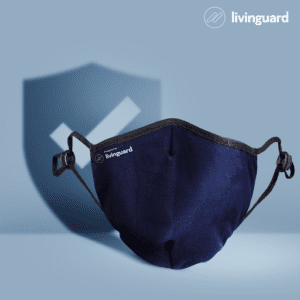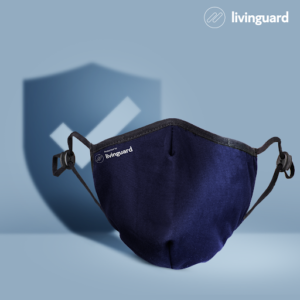The mask had been developed before Covid-19 and was originally meant to be used for tuberculosis patients.
The medical world has been at the forefront of the fight against COVID-19 and their efforts are always commendable. It’s getting to a time when technology has to play a part in this, and it has already been evident in some areas of the world.
Medical innovator, Livinguard, has formulated a line of self-sanitizing masks. It’s a much timely and important innovation as it deactivates SARS-CoV-2, the virus that causes COVID-19, influenza, and many other common viruses.
Speaking to CIO Africa in an interview, the CEO and founder of Livinguard AG, Sanjeev Swamy said that the mask had actually been developed before-covid and was first meant to be used for tuberculosis patients.
“From a lung infection point of view, tuberculosis and coronavirus are very similar. When COVID-19 hit us in 2020, we immediately brought out our masks because we knew it was the perfect mask against coronaviruses.”
The invention comes to modify facemasks into protective wear for the wearer. According to Sanjeev, the technology has been adopted by some regions in the world and there have already been substantial results.
“One country in the world bought our masks and gave it to every person in the country, that is Singapore. Every Singaporean resident received a Livinguard mask,” Sanjeev said, “The report after 7 months was that only less than 500 people out of 6 million had contracted covid.”
The lifespan of a livinguard mask is 6-7 months because it’s washable and reusable. The technology that makes it active for that long is in the fabric that’s used in making the mask. The fabric is the only non-liquid disinfectant in the world.
With a standard cloth or disposable mask, infectious microbes can stick to the mask. If the wearer touches the contaminated mask, that person risks infecting themselves and other surfaces.
Because Livinguard Technology perpetually deactivates the virus and bacteria on the surface of treated masks, it dramatically reduces the chances of cross-contamination.
“We’ve tested it against multiple variants of COVID-19; the original Sars-Cov-2, the global coronavirus (the human coronavirus), the delta variant, and the omicron variant. I can say that this fabric is 99.9% effective in protecting the wearer,” Sanjeev said in the interview.
The radical new mask has been given accelerated approval as a medical mask by the European Union, with universities in Berlin, Germany, and Tucson, Arizona, the USA further confirming that its self-sanitizing fabric kills 99.9 percent of Covid-19 pathogens.
As a medical breakthrough, it was globally honored in 2021, named in September as the Sustainability Product of the year by the Business Information Group, and provoking the World Economic Forum to name its producer, Swiss Medtech company Livinguard, a Global Innovator.
In the years that Livinguard has been operational, Sanjeev is proud of various inventions that have helped over the years. His most proud work is reusable sanitary pads that were produced with the aim of helping the less privileged people in society.
“We targeted to help these girls who mostly fail to go to school because they don’t have sanitary pads or don’t have the money to buy one,” Sanjeev said.
The Kenyan-based anesthesiologist who was one of the early adopters of Livinguard masks, Dr. Idris Chikophe said that it would be good for Africa to embrace this as it is scientifically proven. Dr. Chikophe further said that the masks are not expensive compared to what is being used in the continent and wishes that levies won’t make them expensive when they come to the country.
“The current cost of living is high. The general public is struggling with basic human needs. While the efficacy of the mask is without question, the cost may limit its penetration. I would like it to be considered as an essential medical product so that governments may reduce the prohibitive levies. Maybe we could benefit from bulk procurements too,” Dr. Chikophe said.
Face Masks FAQs
According to the WHO’s website, the following are the frequently asked questions about face masks and their answers.
Why should people wear masks?
Masks are a key measure to reduce transmission and save lives.
Wearing well-fitted masks should be used as part of a comprehensive ‘Do it all!’ approach including maintaining physical distancing, avoiding crowded, closed, and close-contact settings, ensuring good ventilation of indoor spaces, cleaning hands regularly, and covering sneezes and coughs with a tissue of bent elbow.
Depending on the type, masks can be used for either protection of healthy persons or to prevent onward transmission or both.
What kind of mask should the public wear?
There are three types of masks that WHO recommend for the public:
Reusable non-medical masks: Which comply with the ASTM F3502 standard or CEN Working Agreement 17553, or a non-medical mask meeting WHO essential parameters;
Disposable medical masks: Which comply with medical mask standards EN 14683 Type I, ASTM F2100 Level 1, YY/T 0969, YY 0469 (or equivalent);
Other types of well-fitting non-medical masks: Including homemade multi-layered masks, are an acceptable option when other options are not available.
Disposable medical masks are also recommended for the following groups because if infected, they are at a higher risk of becoming seriously ill with COVID-19 and dying:
People aged 60 or over
People of any age with underlying health conditions, including chronic respiratory disease, cardiovascular disease, cancer, obesity, immunocompromised patients, and diabetes mellitus.
Disposable medical masks are also recommended for:
- Anyone who is feeling unwell, including people with mild symptoms, such as muscle aches, slight cough, sore throat, or fatigue.
- Anyone awaiting COVID-19 test results or who has recently tested positive.
When should masks be won by the public?
In settings where there is community or cluster transmission of SARS-CoV-2, irrespective of vaccination status or history of prior infection, wearing a well-fitting mask that covers the nose and mouth is recommended for the public when interacting with individuals who are not members of their household:
- In indoor settings where ventilation is known to be poor or cannot be assessed, or the ventilation system is not properly maintained, regardless of whether physical distancing of at least 1 metre can be maintained;
- In indoor settings that have adequate ventilation if physical distancing of at least 1 metre cannot be maintained; or
- In outdoor settings where physical distancing of at least 1 metre cannot be maintained.
It’s not always easy to determine the quality of ventilation. If you have any doubts, it’s safer to simply wear a mask. While wearing a mask, you should continue to maintain physical distance from others as much as possible. Wearing a mask does not mean you can have close contact with people.
When should health workers wear respirators in the context of Covid-19?
A respirator or a medical mask should be worn by health workers along with other personal protective equipment (PPE) – a gown, gloves, and eye protection – before entering a room where there is a patient with suspected or confirmed COVID-19, including home care, long-term care facilities, and community care settings.
Respirators should be worn in the following situations:
- In care settings where ventilation is known to be poor* or cannot be assessed or the ventilation system is not properly maintained
- Based on health workers’ values and preferences and on their perception of what offers the highest protection possible to prevent SARS-CoV-2 infection.
A respirator should always be worn along with other PPE (gown, gloves, and eye protection) by health workers performing aerosol-generating procedures (AGPs) and by health workers on duty in settings where AGPs are regularly performed on patients with suspected or confirmed COVID-19, such as intensive care units, semi-intensive care units or emergency departments.
What is the difference between medical masks and respirators, like N95s?
Medical masks (also known as surgical masks) are:
- Composed of 3 layers of synthetic nonwoven materials
- Configured to have filtration layers sandwiched in the middle
- Available in different thicknesses
- Have various levels of fluid resistance and filtration
Respirators (also known as filtering facepiece respirators – FFP) are available at different performance levels such as FFP2, FFP3, N95, N99, N100.
Medical masks and respirator masks are similar in their filtration value. However, respirators also have a tight fit around the wearer’s face as the model and size of the respirator are specific to the wearer to ensure an adequate seal.
Respirator masks are designed to protect health workers who provide care to COVID-19 patients in settings and areas where aerosol-generating procedures are undertaken.
They are also recommended for health workers providing care to suspected or confirmed COVID-19 patients in settings where ventilation is known to be poor or cannot be assessed or the ventilation system is not properly maintained
Health workers should be fit tested before using a respirator to ensure that they are wearing the correct size. Wearing a loose-fitting respirator will not offer the same level of protection to the wearer as it may allow small particles to get inside the mask where there are gaps, for example through the side.
How do I choose what fabric mask to buy?
Filtration, breathability, and fit are all important.
If you purchase a non-medical mask, check the labels to make sure it complies with the ASTM F3502 standard or CEN Working Agreement 17553.
If you choose to make your mask, it should be made of three layers of fabric:
- The inner layer of absorbent material, such as cotton.
- The middle layer of non-woven non-absorbent material, such as polypropylene.
- The outer layer of non-absorbent material, such as polyester or polyester blend.
Watch the video on WHO’s recommended fabric mask materials and composition for more information.
For either type of mask, you should choose the one that fits your face well – cover your nose, cheeks, and chin without leaving gaps on the sides. Masks with vents or exhalation valves are not advised because they allow the unfiltered breath to escape the mask.
Should I wear a mask while exercising?
Even when you’re in an area of COVID-19 transmission, masks should not be worn during vigorous physical activity because of the risk of reducing your breathing capacity. No matter how intensely you exercise, keep at least 1 metre away from others, and if you’re indoors, make sure there is adequate ventilation.




